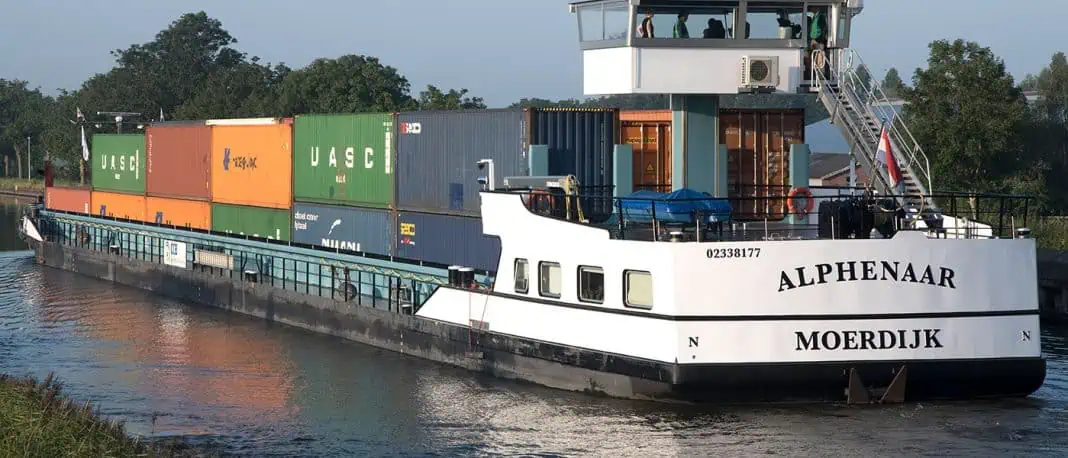September 6, 2021 – Today Zero Emission Services (ZES) will start shipping the Alphenaar, the first Dutch inland vessel to use interchangeable energy containers for propulsion. The Alphenaar sails between Alphen aan den Rijn and Moerdijk for beer brewer HEINEKEN, the first end customer of ZES.
This makes the commissioning of the innovative energy system of ZES for inland shipping a fact. The energy containers – “ZESpacks” – are standard 20ft containers filled with batteries, which are charged with green electricity. The first two ZESpacks are loaded and exchanged at the first charging station at the CCT terminal in Alphen aan den Rijn. ZES has the ambition to scale up in the short term and wants to realize 30 zero-emission shipping routes by 2030. The company was founded last year by ENGIE, ING, Wärtsilä and the Port of Rotterdam Authority, with the support of the Ministry of Infrastructure and Water Management, and is thus taking an important step in the transition to emission-free inland shipping.
System change of inland shipping
Inland shipping plays an important role in reducing environmental emissions. Within transport, inland shipping is responsible for 5% of CO2 emissions in the Netherlands. In addition, 11% of the total Dutch NOx emissions are caused by inland shipping. In order to achieve the goals of the Climate Agreement, the Green Deal for Sea Shipping, Inland Shipping and Ports has the ambition to reduce emissions in inland shipping by 50% by 2030. Achieving this goal requires a transition to fully electrically powered transport over water. ZES provides the solution to put this system change into effect: a complete service package based on exchangeable energy containers with green energy, open-access charging infrastructure and a pay-per-use payment concept for ship owners. The charging stations can act as energy hubs that can stabilize the grid during peak loads and where other vehicles can also charge. Because of their mobility, ZESpacks can be used to supply and store energy at all kinds of locations, such as construction sites and festivals.
A truly green solution for governments and businesses
“The energy concept that ZES is launching on the market makes a direct contribution to reducing emissions by saving around 1,000 tons of CO2 and 7 tons of NOx per ship per year. In addition, ships sailing with ZES do not produce particulate matter and noise,” says Willem Dedden, CEO of ZES. The concept also includes the organization of the required charging infrastructure and a pay-per-use construction that allows skippers to pay only for the use of energy. The investment in ZESpacks is for the account of ZES. This setup makes ZES very user-friendly and scalable. Dedden: “ZES offers governments and companies a ready-made solution to become more sustainable.” One of those companies is HEINEKEN, which, together with carrier CCT, is the first customer of ZES with a ten-year contract.
To standardize is to accelerate
Dedden: “In addition to directly contributing to the realization of emission-free inland shipping, ZES is setting a standard that accelerates the transition to emission-free inland shipping. We lay the foundation with our ZESpack (a standard 20 ft container) and a standard connector (the “plug”). In combination with the financing and pay-per-use package devised by ING, ZES offers skippers an accessible, future-proof open access innovation. The ZESpacks system adapts as technology advances: the ZESpacks currently in use work with lithium-ion batteries, but in the future this could also be hydrogen, ammonia or something else. The ZESpack always fits on the connection, regardless of the type of energy in the container.” For this reason, ZES releases the profiles for the connector without rights,
From construction to speed
Wärtsilä, supplier of the first ZESpacks, has been working in recent months on assembling and testing the energy containers, which are equipped with safety and communication systems, and 45 battery modules totaling 2MWh – equivalent to the capacity of some 36 electric cars. . The ZESpack is completely tailor-made for ZES. Particularly unique is the interchangeability of the containers, which until now have been stationary installations. The ZESpacks are charged with certified green energy at the first ZES charging station at the Alpherium, the container terminal of CCT in Alphen aan den Rijn. This charging station, developed by ENGIE, was completed in April. In July, the Alphenaar was converted and fitted with, among other things, the standard connector connection to be able to receive the ZESpacks. The first successful sea trial took place at the end of August. With the start of the operation, ZES will gain user experience in the near future in order to achieve completely emission-free shipping as quickly as possible.
Upscaling
ZES has the ambition to scale up to eight ships, eight charging stations and fourteen ZESpacks in the short term. The company wants to realize 30 zero-emission shipping routes by 2030, which can save up to 360,000 tons of CO2 and 2,800 tons of NOx. In order to really compete with fossil fuels, simultaneous action and commitment from the government, ports and terminals as well as the business community are required. ZES is working closely with national, regional and local governments and forward-thinking carriers such as BCTN to contract the following vessels and develop the associated network of charging stations, starting in Rotterdam, Moerdijk and Alblasserdam.












